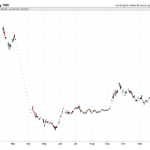In 1981, the price of silver experienced a significant rollercoaster ride, with prices fluctuating from highs to lows over the course of the year. The price reached its highest point on January 6th at $16.30 per ounce and dropped to its lowest point on June 30th at $8.30 per ounce. Throughout the year, daily silver prices ranged from $8.04 to $11.24 per ounce.
The fluctuations in silver prices during this period were influenced by a variety of factors, including changes in the rules of the commodity exchange, government policies, and global economic conditions.
This article will delve deeper into the price history of silver in 1981, exploring the factors that affected the market and the impact of the COMEX rule changes on the price of silver. By analyzing these factors, we can gain a deeper understanding of the factors that influence precious metal prices and the dynamics of the commodities market.
Price History Overview
The overview of silver price history in 1981 provides a detailed account of the daily prices of silver in US dollars per troy ounce, ranging from the lowest price of $8.30 oz on June 30th to the highest price of $16.30 oz on January 6th.
The LBMA Silver Price Fix data shows that prices in August 19-28, 1981 ranged from $8.70 to $10.03 per oz, while prices in December 29-31, 1981 ranged from $8.05 to $8.15 per oz.
The fluctuation in silver prices in 1981 was mainly influenced by inflation impact and global events.
During the early 1980s, inflation was a significant concern, and the high silver prices reflected the economic uncertainty at the time.
Additionally, global events such as the Iran hostage crisis and the Soviet invasion of Afghanistan also contributed to the volatility of silver prices in 1981.
The COMEX rule changes also played a role in the price fluctuations, leading to increased speculation and market uncertainty.
The summary of the silver price history in 1981 highlights the importance of understanding the various factors that can influence commodity prices and the need for careful analysis of market trends to make informed investment decisions.
Factors Affecting Prices
Factors such as rule changes and market conditions played a significant role in influencing the price fluctuations of silver during the year 1981. COMEX rule changes, for instance, had a significant impact on the price of silver during the year. In response to the Hunt Brothers’ attempt to corner the silver market, the COMEX introduced new rules that limited the amount of silver that could be purchased on margin. These rule changes led to a significant decrease in demand for silver and, consequently, a drop in prices. Additionally, market conditions such as supply and demand, as well as geopolitical events, also affected the price of silver during the year.
Supply and demand played a significant role in the price fluctuations of silver in 1981. A decrease in the supply of silver, for instance, would lead to a rise in prices, while an increase in the supply of silver would lead to a drop in prices. Geopolitical events such as the political tensions between the US and Iran also played a role in the price of silver during the year. The Iranian revolution led to a decrease in the supply of oil, which in turn led to a rise in inflation and a rise in the price of silver. Overall, a combination of factors such as rule changes, supply and demand, and geopolitical events contributed to the price fluctuations of silver during the year 1981.
Impact of COMEX Rule Changes
COMEX rule changes in 1981 had a significant impact on the silver market. The new margin requirements forced some investors to liquidate their positions, which led to a decrease in demand for silver. This regulatory impact may have contributed to the drop in silver prices, as investors who were unable to meet the new margin requirements were forced to sell their silver holdings.
Additionally, the uncertainty surrounding the new regulations may have caused some investors to become hesitant about investing in silver, further dampening demand. The effect of COMEX rule changes on the silver market in 1981 highlights the importance of regulatory policy in commodity markets.
Changes in regulations can have a significant impact on market dynamics, and it is important for policymakers to consider the potential consequences of their actions. In the case of silver prices in 1981, the new margin requirements had a negative effect on demand for silver, which ultimately led to a decrease in silver prices.
Frequently Asked Questions
What was the political and economic climate in 1981 that influenced silver prices?
The political unrest and economic recession of 1981 may have influenced silver prices. The Reagan administration’s policies, including deregulation and tax cuts, led to high inflation and a recession. Additionally, tensions with the Soviet Union and the Iran hostage crisis may have added to instability in the market.
How did the daily fluctuations in silver prices affect the demand for physical silver products?
Market trends indicate that fluctuations in daily silver prices in 1981 did not significantly affect the demand for physical silver products. However, factors such as COMEX rule changes and LBMA silver price fix may have had a greater impact on market behavior.
What was the impact of the LBMA Silver Price Fix on the overall silver market in 1981?
The LBMA Silver Price Fix, which began in 1897, had a significant impact on the silver market in 1981. The regulations set by the LBMA affected investors’ decisions and influenced the daily fluctuations in silver prices.
How did the price of silver in 1981 compare to other precious metals like gold and platinum?
In 1981, the price of silver ranged from $8.30 to $16.30 per ounce. Compared to gold, which had a price range of $375 to $614 per ounce, silver had a lower price point. Platinum had a higher price point than both, ranging from $568 to $699 per ounce.
What were the long-term effects of the COMEX rule changes on the silver market beyond 1981?
The aftermath of the COMEX rule changes in 1981 had long-term effects on the silver market trends. The changes affected the trading practices and regulations, leading to a shift in market dynamics and investor confidence. However, the exact impact on the market is difficult to quantify due to the presence of other factors that influence silver prices.





